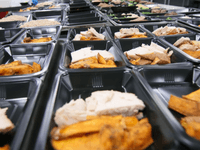Planning and Operating Large-Scale Food Production in the Age of Ghost Kitchens
Table of Contents
CloudKitchens
How many tacos can be delivered from a 1000sqft restaurant?
The same amount as a 200sqft ghost kitchen.
A strategic guide to designing, scaling, and managing high-volume kitchen operations using ghost kitchen models.
The demand for large-scale food kitchen production is growing rapidly, and to keep up with this pace, companies need efficient operations that ensure both quality and speed. Centralized kitchens have emerged as a solution to these challenges, enabling fast deliveries and strict production control.
Expanding production without the right facility can lead to many obstacles, such as regulatory delays, lack of refrigerated space, and low productivity, which can compromise both quality and business growth. Therefore, having a well-planned scalable kitchen space designed for bulk operations is essential to guarantee efficiency and meet market demand.
In this guide, you will learn about the main challenges of scaling operations, the differences between building or renting a shared kitchen for production, the essential features of high-volume production environments, and the advantages of ghost kitchens, designed specifically for delivery preparation.
Read more: How to streamline operations and scale with strategies to handle high volume catering orders
The Rise of Large-Scale Food Production in Delivery-First Markets
The demand for large-scale food production continues to grow, especially in major urban centers. To keep pace, many companies are shifting to centralized production kitchens designed for efficiency and quick deliveries.
These facilities enable large-scale production with quality control, reduced waste, and increased speed. Below are examples of market segments driving this shift in the delivery industry.
Ready Meals and Meal Kits
Approximately 40% of Americans order ready meal kits three to five times a month, highlighting how recurring consumption has become part of everyday life. This trend requires operations capable of high-volume production, standardization, and swift order assembly and dispatch.
Catering and Corporate Buffets
There are over 94,000 catering companies in the United States, serving events, offices, and large corporate contracts. To meet these volumes consistently and quickly, commissary kitchen spaces provide the proper infrastructure for large-scale production and deadline management.
Wholesale Food Products
The sector has about 408,000 businesses in the U.S., moving nearly US$ 10 trillion. To supply supermarkets, restaurants, and distributors, wholesale food prep kitchens must be prepared for high-volume production while maintaining safety standards and delivery regularity.
Common Challenges When Scaling Without the Right Kitchen
Expanding food production without an appropriate facility can undermine efficiency and service quality. Many businesses face hurdles that stall growth and increase operating costs, especially in logistics-intensive delivery markets.
Below are the main challenges food producers encounter when trying to scale without a kitchen designed for high performance:
Delays in Permits and Licensing
Setting up a kitchen from scratch can take months just to get the necessary regulatory approvals. These delays impact expansion schedules and delay sales launches.
Inefficient Layouts
Poorly planned kitchens disrupt workflow, causing production bottlenecks and making it difficult to meet deadlines. This directly affects team productivity and order quality.
Insufficient Refrigerated Space
Without adequate refrigeration infrastructure, ingredient waste risks increase, and food safety is compromised. It also limits the variety of items that can be produced or stored.
Difficulty Assembling Qualified Teams
Improvised or low-infrastructure spaces deter experienced professionals, making it harder to build and retain a stable, skilled workforce.
Regulatory Barriers
Lack of sanitary or technical compliance prevents obtaining certifications and permits necessary to serve new markets such as wholesale or corporate catering.
Calculating the True Cost of Building vs. Renting a Production Kitchen
When deciding how to expand or start a food operation, many entrepreneurs face a strategic choice: build a kitchen from scratch or rent a ready-to-use space. This decision directly affects time to market, costs involved, and scalability.
Building might seem advantageous for those seeking full control, but it involves high investment and long timelines. Renting a ready production kitchen reduces bureaucracy, speeds up operations, and minimizes financial risks.
Here is a practical comparison of the two paths:
Time to Start Operations
- Building: Can take up to 6 months for design and approvals, plus additional time for construction and equipment installation.
- Renting: Ready-to-use models, like shared kitchens, allow starting in a few weeks with all infrastructure already approved.
Initial Investment Cost
- Building: Costs can reach $350,000 or more, depending on location, infrastructure, and equipment standards.
- Renting: Initial investment can start around $30,000, including equipped kitchen, licenses, storage, and support.
Labor and Project Complexity
- Building: Requires hiring and coordinating engineers, suppliers, construction teams, and complying with sanitary regulations.
- Renting: Transfers these responsibilities to the kitchen operator, letting entrepreneurs focus solely on running their business.
Risks and Financial Return
- Building: Subject to delays, cost overruns, and unforeseen issues that can impact ROI.
- Renting: Reduces operational risks and enables faster return, ideal for market testing or launching brands quickly.
Indirect Costs and Maintenance
- Building: Involves ongoing expenses for equipment maintenance, technical updates, and mandatory regulatory compliance.
- Renting: Offers a full package with modern food production infrastructure and included support, reducing indirect costs and surprises.
For businesses valuing flexibility and lower financial risk, renting is an intelligent alternative. It allows testing concepts, expanding to new regions, and focusing on growth without the complications of construction.
Read more: How shared kitchens help reduce overhead costs for food businesses
Features to Prioritize in a High-Volume Kitchen Rental
Choosing a kitchen for large-scale production means more than just considering rental cost. It is crucial to assess whether the space provides the infrastructure necessary for efficiency and scalability. An inadequate kitchen can limit output, increase errors, and impact final service quality.
Here are key criteria that make a difference in operational performance and the ability to consistently meet high volumes.
Built for Storage and Workflow Efficiency
To keep large-scale production running smoothly, the kitchen layout and organization must maximize space use and avoid bottlenecks. Below are the most important elements to ensure workflow fluidity and efficiency in order preparation:
- Cold storage rooms with easy access to preparation areas
- Industrial shelving for organization and quick access
- Large worktables for simultaneous preparation of multiple orders
- Workstations separated by production stage
- Dedicated space for order assembly and packaging
- Clear aisles and layouts that avoid task crossing
- Adequate lighting and ventilation for team comfort and safety
Designed to Support Multi-Channel Distribution
A modern, efficient kitchen must be able to serve multiple sales channels simultaneously without losing process control. Key features that enhance speed and accuracy include:
- Dispatch areas equipped for delivery, wholesale, and events
- Separate pickup zones by distribution channel
- Systems for order identification and route labeling
- Infrastructure ready to serve third-party platforms and direct sales
- Capacity to operate multiple brands or product lines within the same space
- Operational flow adaptable to demand peaks across different fronts
- Organization that allows agility without compromising final quality
Key Compliance and Safety Standards for High-Volume Kitchens
Operating a high-volume production kitchen requires not only operational efficiency but strict compliance with sanitary, legal, and structural standards. These requirements ensure food safety, reduce public health risks, and protect businesses from legal penalties.
Here are the main standards and regulations to be followed:
- HACCP (Hazard Analysis and Critical Control Points): Mandatory system to identify food safety risks and apply preventive measures at each production stage.
- Health and Safety Regulations: Rules ensuring good practices in food handling, personal hygiene, temperature control, and sanitation.
- ADA (Americans with Disabilities Act): Requires physical accessibility in facilities, including entrances, restrooms, and work areas.
- Food Handling Hygiene Standards: Regulations governing cleaning of surfaces, equipment, utensils, and preparation areas to avoid cross-contamination.
- Fire Safety Requirements: Include emergency exits, appropriate extinguishers, ventilation systems, and smoke and heat detectors.
- Employee Training and Certification: Staff must receive ongoing food safety training and hold certifications required by local authorities.
- Pest Control Measures: Require frequent inspections, infestation prevention, and safe application of control methods in critical areas.
- Waste Management Guidelines: Define proper disposal of organic, recyclable, and hazardous waste to prevent environmental and sanitary risks.
- Mandatory Record Keeping: Includes temperature logs, expiration dates, production batches, and cleaning protocols.
- Supplier Compliance Criteria: Ingredient suppliers must meet equivalent safety and traceability standards to ensure supply chain integrity.
Why Ghost Kitchens Are Ideal for High-Volume Production
Ghost kitchens, also known as dark kitchens, offer a modern alternative to traditional kitchens by focusing in optimized spaces for food production either for restaurants, caterers, and CPUs . Without the need for customer-facing spaces, they optimize resources and costs, benefiting large-scale operations.
This model allows resource optimization, cost reduction, and faster market entry, especially for delivery-focused businesses. Below are the main advantages of ghost kitchens for high-volume production:
- Faster Setup: Ready-to-use spaces with no long construction or complex adaptations, speeding up operation start.
- Lower Fixed Costs: No dining areas, front-of-house staff, or furniture reduces rent, labor, and maintenance expenses.
- Integrated Logistics: Strategic locations near urban centers and delivery routes optimize time and transportation costs.
- Scalability in the Same Space: Ability to operate multiple brands or menus simultaneously, boosting productivity without expanding physical footprint.
- Production Focus: Teams and facilities dedicated solely to preparation and packaging improve quality and consistency.
- Operational Flexibility: Quick menu and volume adjustments based on market demand without structural impacts.
- Risk Reduction: Lower upfront investment and reduced bureaucracy make it easier to test and expand new concepts.
Explore High-Volume Kitchen Rental Opportunities With CloudKitchens
If you want to expand your food production with speed, efficiency, and expert support, CloudKitchens’ units provide the ideal infrastructure for growing businesses. With plug and playkitchens, strategic locations, and integrated technology, scaling operations becomes hassle-free.
Don’t miss the chance to see these spaces designed for high demand up close. Schedule a visit and talk to a CloudKitchens specialist to find the perfect solution for your business needs and accelerate your success.
FAQ – Large-Scale Food Production and Ghost Kitchens
What makes ghost kitchens ideal for large-scale food production?
Ghost kitchens reduce overhead by focusing solely on delivery, allowing for flexible scaling and streamlined operations without a traditional storefront.
How can I ensure quality and consistency in a ghost kitchen model?
Implement strict food safety protocols, use standardized recipes, invest in staff training, and utilize technology for real-time monitoring and order management.
What challenges should I expect when operating at scale with ghost kitchens?
Common challenges include managing logistics, coordinating multiple delivery platforms, maintaining supply chain efficiency, and handling fluctuating demand.
DISCLAIMER: This information is provided for general informational purposes only and the content does not constitute an endorsement. CloudKitchens does not warrant the accuracy or completeness of any information, text, images/graphics, links, or other content contained within the blog content. We recommend that you consult with financial, legal, and business professionals for advice specific to your situation.
More insights & stories
There’s more where that came from.
Get in the know and check out our additional insights




